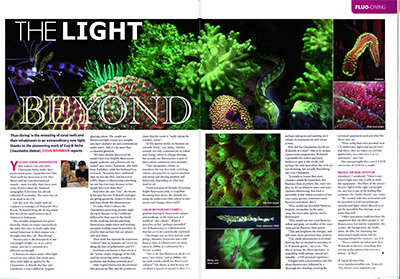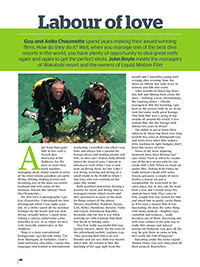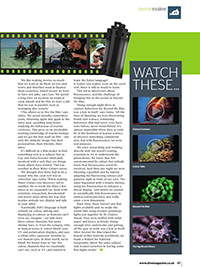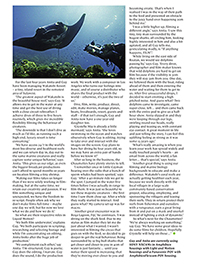Fluo-Diving
Pioneers of Underwater FluorescenceHow would you like to discover something so different and magical, that you will never see marine creatures the same way again?
Fluo-diving in Cozumel is a private, global exclusive, one-on-one with the Pioneers, Researchers and Nat Geo award-winning Filmmakers who brought this extraordinary phenomena to the big screen.
“Having seen the underwater fluorescence movies of Anita and Guy, I was burning to see this exciting new effect with my own eyes. Taking my daughter along for a thrilling lesson in physics made it even more fun. Gliding over the reef top, hidden animals in screaming bright fluorescent colors were suddenly easy to spot – we felt like 007 with a secret weapon.” (Lorenz Maeder)
A Dazzling, Magical World of Fluorescence
In what was labeled ‘the underwater series of the decade’ and ‘a pioneering breakthrough in underwater communication’ internationally acclaimed cinematographers Liquid Motion Film brought the phenomenal imagery of underwater fluorescence to giant screens around the world for the very first time back in 2009.
‘Beyond The Blue’ was a short trailer made in 2006 for the exclusive National Geographic ‘Water Colours’ Series. It won over 35 major international awards and continues to rock the world of marine science today.
Back in early 2007, feeling like we were going back to premier ocean discovery, we named this extraordinary phenomena ” FLUO-Diving”.

“Fluo-diving is a psychedelic disco, with neon lights. It’s like being in James Cameron’s movie Avatar. It’s a night dive like no other, discovering a hidden world within the already elusive world of the reef at night. Guy and Anitas work about fluorescence is a milestone, it makes something known to the large public that was unknown throughout the whole history of mankind. It is like the first pictures from Mars from the first probes landing there!
(Steffen Beyer PhD).

Not to be confused with phosphorescence, or bio-luminescence, fluorescence is the absorbtion of one wavelength of light (or colour) and the re-emission of another, totally different wavelength of light (or colour). colour.
When a fluorescent object is seen under sunlight, it appears normal. But when struck by a near-UV light source, it absorbs the blue light spectrum and re-emits a fluorescence of an entirely different color.
Thus, underwater, marine animals that fluoresce have the ability to convert one colour into an entirely different colour!
Dr. Charles Mazel Ph.D & leading Fluorescence Research Scientist & inventor of fluotechnology:
“The odds of you going in the water and finding something, seeing some animal fluorescing, that no-one else in the entire history of the universe has ever seen is probably over ninety percent! Anywhere in the world. Simply because so few people have done this”…
Fluo-Diving: How it all began
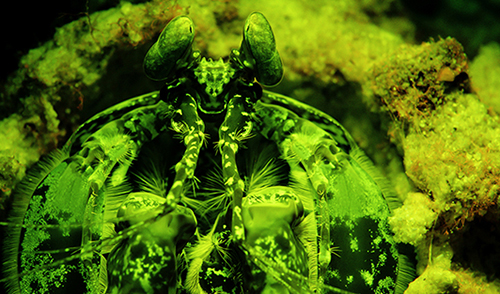
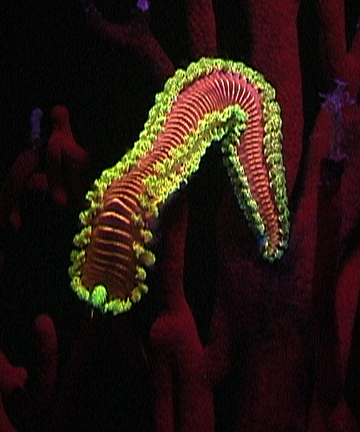

PIONEERING THE SCIENCE – TESTING THE PROTOTYPES
In 2004, working alongside the worlds leading Marine Research Scientists to unravel the mysteries of underwater communication, Guy and Anita began an epic 4 year journey of documentation and research.
Traveling the Caribbean islands, they made night dive after night dive, filming with the first prototype lights made by Researcher Dr Charles Mazel – huge, near-UV sources, that they carefully had to stuff with cotton wool and tissue paper before each dive!.
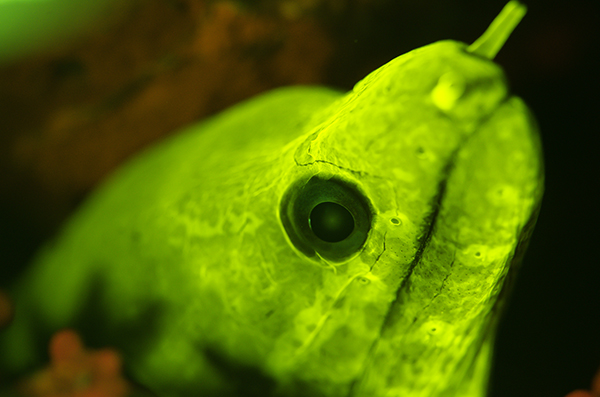
The journey culminated in international press, highest accolades, global recognition, over 50 major Awards, and a revolutionary series which fast became a National Geographic Television exclusive known as ‘Water Colours’.
Asking “Why are marine animals such incredible colours?”, and conclusively proving that “colour is the prime cryptic language of the fish”, we explored marine animals visual systems, unraveled crypsis and camouflage, deciphered how fish change colour and pattern to express emotion and mood and, in a world premiere, for the first time ever, documented the integral role that fluorescence plays in marine animals daily lives.
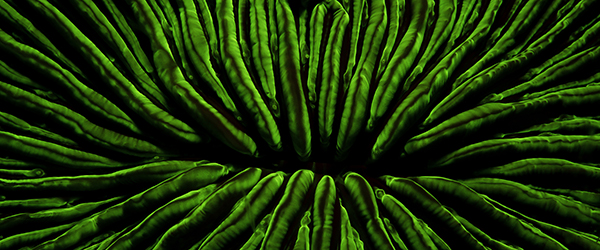
PIONEERING THE FLUO-DIVE
In 2009, Liquid Motion brought the technology, know-how, cutting-edge equipment and mesmerizing experience to the world of recreational diving, naming it ‘fluo-diving’. They first launched it on the island of Wakatobi, where they lived, filmed, researched and managed the resort for the subsequent 4 years.
As guests joined them as Pioneers, making discoveries no-one else had ever seen, they continued to witness extraordinary behaviour, brand new science and mind-blowing phenomena that, even today, the worlds leading Research Scientists are still striving to understand.
From Green Blennies becoming pink, to the exhilarating first ever 600m deep fluorescent shark, vivid, electrifying images revealed marine animals changing the very course of nature – yet only heightened the ultimate questions of how they do this, and why.
The journey culminated in international press, highest accolades, global recognition, over 50 major Awards, and a revolutionary series which fast became a National Geographic Television exclusive known as ‘Water Colours’.
Today, several dive centers around the world that offer fluo-diving. Yet with each dive comes a new discovery, and more questions arise. The true reason for fluorescence in corals remains unclear, but the reason for fluorescence in more complex creatures is completely obscure. The subject of fluorescence extends all boundaries in understanding and even now remains as controversial as it is fascinating.
In an environment dominated by blue, bright colours are quickly absorbed in just a few feet, But fluorescence is a way to maintain bright colours. Professor Justin Marshall, Neurobiologist, Zoologist, Research Scientist, Doctor of Philosophy, Marine Biologist, Global Leader in colour vision, visual behaviour, colour change:
“For the fish, for the animals on the reef, being colourful is about really wanting to say something. They’re using fluorescence as part of their colour communication channel. It’s a way of being even more colourful than colourful” …
(Prof Justin Marshall PhD)

BACK TO PREMIER OCEAN DISCOVERY
Fluorescence is found in such a wide range of species, that Scientists speculate it must provide some sort of benefit for the animals. Some studies suggest it could act as a sunscreen, protecting corals, particularly in shallow water, from harmful UV radiation. Another hypothesis is that fluorescence allows corals to transform the only light available to them – blue light – into wavelengths that can be used by their symbiotic algae to photosynthesise in darker, light-limited environments. And when it comes to fish, it is thought to be related to communication.
Following the ‘Water Colours’ series, its widely understood that fish use color as their primary means of communication; their colors and patterns are used to attract mates, evade predators and stalk prey. You’ll have seen this yourself on dives, with octopus, squid and cuttlefish. But it’s a new idea that animals use fluorescence to do this. It seems some fish have a secret and private communication channel of their own!
Fluorescence is starting to become an important tool for biomedical research, as it can be used to study changes within living organisms. One of the most important such discoveries came from a type of tube anemone that fluoresces only under a very specific wavelength of light. By isolating the protein that makes this anemone glow, researchers now hope to use this ability to switch florescence on and off to delve deeper into the inner workings of cellular biology.
In addition to the visually exciting aspects of fluo-diving, there’s the distinct possibility of discovery. Because this phenomenon is relatively new to the scientific and diving communities, new discoveries are made on a regular basis, and on any given dive, there’s a chance to observe a new type of fluorescent behavior or reveal a previously-unknown species. For example, during a recent NOAA expedition, researches working in very deep water came across a fluorescent shark.
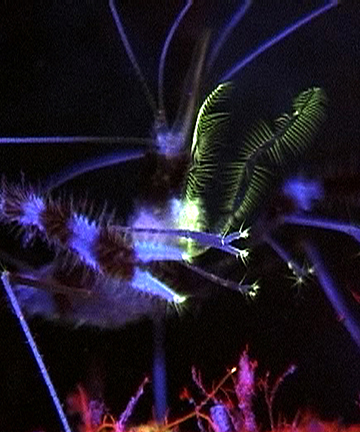
In daylight this tiny Banded Coral Shrimps mandibles are invisible. At night, if we excite her using our special lights, she uses fluorescence to transform her mandibles from clear/white, to a bright fluorescing yellow glow – which Scientists believe may help her capture the tiny copepods and prey.

Observe how the muted colors of the fireworm are transformed in to something exquisite in Fluo-Diving. Its colors change as it transforms from juvenile to adult.

Why would two identical corals, side by side, behave in completely different ways? Using our special lights, one fluoresces back a bright lime green colour, the other fluoresces bright pink.. or yellow… or doesn’t fluoresce at all!
During a NOAA Deep Scope Expedition, Prof. MIKHAIL V. MATZ PH.D , Research Scientist at the Integrative Biology Section of the University of Texas and contributing Scientist to our ‘Water Colours’ Series, was around 1820′ depth in a sub.
He came across this awesome fluorescent shark.
Why a shark at such depth would be using the subs lights to fluoresce is a total mystery to science, but perhaps since this shark’s known to ascend up to 60 meters, where light IS available, we can theorize that his fluorescence may help him communicate and find some mates.

Many creatures that stay concealed and are hard to spot during the day or the night are revealed in a fluo dive. They might be transparent, or masters of camouflage, but many will shine spectacularly under a blue light.
Guest Wayne MacWilliams shares his awesome shots of a fluoresce, and the wild, florescent colours of the animals and corals.
“A FANTASTIC Night Dive! The fluo-dive was magical, and incredibly interesting. Diving with black lights and filters on our masks was exhilarating and the fluorescence of marine life was beyond our wildest imagination. Seeing the fluorescence of marine life at night leads us to wonder WHY!?” (Eva and John Centanni)
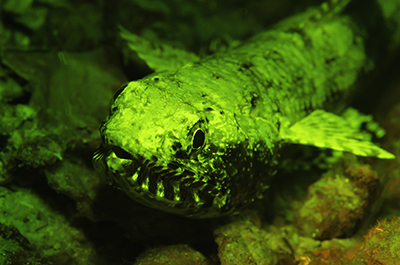
THE DIVE
Fluo-diving is conducted with the Pioneers, as a one-on-one or buddy-diving experience.
Fluo-diving is a part of Liquid Motions VIP Private Diving Services.
What it includes:
The experience begins with a media presentation and explanation about fluorescence, including what fluorescense is, what this means underwater and how we see it .
This is followed by a thorough briefing about the dive you are about to do, the equipment you will use and how and what you may discover.
Then, using your near-UV underwater lights and special visor and filters, you will be taken on a minblowing, privately guided dive, one-to-one with The Pioneers.
Fluo-Diving is a private diving experience with the Pioneers. There is a maximum ratio of 1:2 at all times. Duration of the total fluo experience will be approx 3 hours.
Note: Fluo-diving is for experienced divers with perfect buoyancy and ample night diving experience only, as vision is more limited than on a regular night dive


